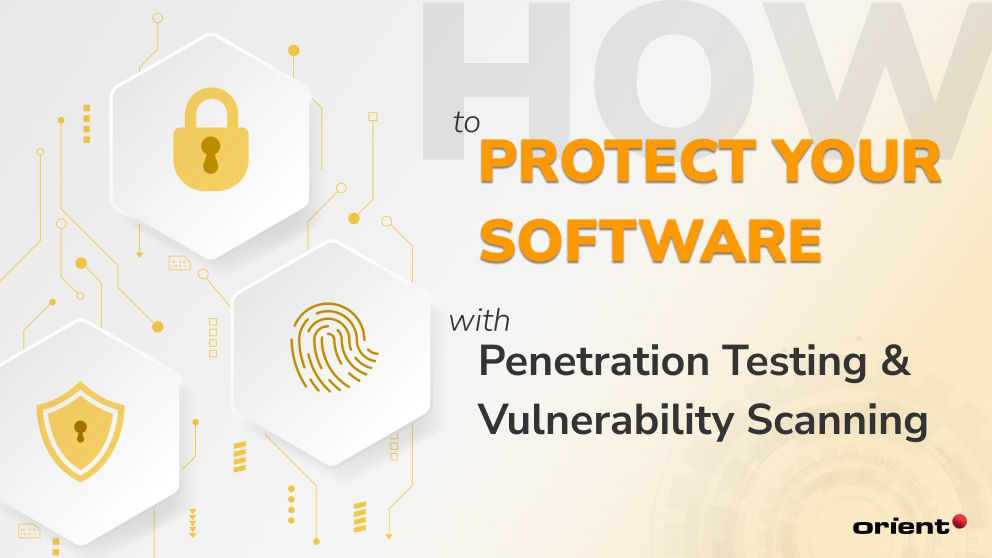How to Protect Your Software with Penetration Testing and Vulnerability Scanning

Content Map
More chaptersKeeping your software secure is vital to preventing threat actors – both internal and external ones – from exploiting the vulnerabilities in your software. That is why it is so important that you regularly assess your software for security gaps, and by far, the two best ways to do this are penetration testing and vulnerability scanning.
When used in conjunction with the Agile methodology, which is how we work at Orient Software, these two testing techniques can do amazing things. Not only can they spot potential security vulnerabilities, but also determine if those vulnerabilities are exploitable. They can even outline the steps that a threat actor may take to exploit those vulnerabilities.
In this article, you will learn what penetration testing and vulnerability scanning is. You will also learn what makes these testing techniques unique and why they should be part of your software development project.
What Is Penetration Testing?

Penetration testing is the act of determining whether a security vulnerability is exploitable. Penetration testers simulate the kind of hacking techniques that a real threat actor may use to exploit one or more vulnerabilities in a software product to answer this question. The ultimate aim of penetration testing is to determine how likely a threat actor is to succeed if they use specific hacking techniques. By doing so, penetration testers can accurately assess the threat level of each vulnerability, and if the threat level is high enough, they can then advise the security team to close those vulnerabilities.
Penetration testing requires the use of unethical hacking tools, techniques, and procedures. However, the intent behind the use of these measures is not to compromise software but to better understand how a real threat actor may use them. Naturally, this requires the permission and authorization of the software owner, with the understanding that mimicking these real-world hacking techniques will help resolve any security vulnerabilities. Common hacking techniques include SQL injections (where a threat actor will access and modify an SQL database) and password cracking (where a threat actor uses certain apps and programming techniques to guess user passwords).
What Is Vulnerability Scanning?
Vulnerability scanning involves the use of automation and other testing tools to identify potential vulnerabilities in a software product. Testers will then report the results of the vulnerability scans to penetration testers, who conduct further investigations to assess their nature and threat level. The penetration testers will then advise the security team on how to resolve any exploitable vulnerabilities.
Vulnerability scanning is faster, cheaper, and easier to perform than penetration testing, as it involves merely scanning the software for vulnerabilities. Any further action is followed up with penetration testing. For this reason, vulnerability scanning can be (and should be) conducted more frequently than penetration testing.
What Are the Differences Between Penetration Testing and Vulnerability Scanning?

There are many differences between a penetration test and a vulnerability scan. These differences relate to how they use automation, the frequency with which to use them, and the outcomes they can achieve. Below is a detailed breakdown of what makes these two testing techniques unique.
Automation Capabilities
Vulnerability scanning makes prominent use of automation, which helps speed up the testing process and increase the number of endpoints that the system can scan. When configured properly, an automated vulnerability scanner can scan thousands of endpoints. The use of artificial intelligence (AI) in quality assurance and testing is on the rise, too. For example, organizations in the financial sector are using AI to detect fraudulent activity, and testers are using AI to automatically generate test scripts.
Penetration tests are less reliant on automation than vulnerability scanning, as the process is more detailed and nuanced. It requires the care and precision of a human tester, who can determine the likelihood of successful cyber-attacks. That said, there are many automated penetration testing tools out there, but they still require manual checking from a human tester to rule out false positives.
Test Frequency
Since a vulnerability scan is faster and cheaper to perform than penetration tests, it is easier to perform on a more frequent basis. Ideally, companies should perform vulnerability scans at least once per quarter or even once per month. This enables a company to stay on top of the latest emerging digital threats.
By comparison, penetration testing is a more involved, expensive, and time-consuming software testing method. Therefore, it is not possible to conduct penetration testing as often as a vulnerability assessment. As a rule of thumb, testers should conduct penetration testing at least once every six months to a year or more often for compliance reasons.
Achievable Outcomes
Vulnerability scans help identify and confirm the existence of potential security vulnerabilities in a software product. It does not assess the severity of a vulnerability, nor does it confirm that a vulnerability is even exploitable; it merely confirms the existence of a potential threat.
On the other hand, a penetration test goes further. It involves human testers mimicking different hacking techniques to determine if a vulnerability is exploitable. If the attempt is successful, the security team can then use this information to resolve those vulnerabilities.
What Are the Different Penetration Testing Techniques?
There are many different software testing types out there. All of these are designed to test different components of a software product, including the networks and operating systems. These include:
- Black Box testing – Simulated hacking attempts that involve little to no information about (or access to) the IT infrastructure of a software product.
- Grey Box testing – Where the tester has some information about (or access) to the IT infrastructure of a software product. These tests assess the quality of the internal security controls within a software product.
- White Box Testing – Where the tester has full access to the IT infrastructure of a software product. It thoroughly evaluates the internal security controls of a software product, including the network and operating system.
- Network Testing – This involves evaluating the different components of a network’s internal security controls. These include the network’s firewalls, servers, switches, routers, and any connected devices (e.g., printers, laptops, desktop workstations) that operate on the same network.
- Social Engineering – This involves evaluating the security knowledge of a team working at an organization. An example of a social engineering test would be sending simulated phishing emails to internal staff and then seeing who will pass or fail the test based on who responds to the email (e.g., accidentally shares their login credentials).
- Wireless – Testing the different wireless connections that reside within an IT infrastructure. These include testing all possible entry points, such as Internet of Things (IoT) security solutions, mobile devices, and desktop workstations.
How Does Penetration Testing and Vulnerability Scanning Work?
This is a detailed breakdown of the steps involved in performing both penetration testing and regular vulnerability scanning. By understanding the process behind each testing method, you will gain a deeper understanding of how they work and what they can do for you.
For more information about general software testing, read the ultimate guide to software testing.
Penetration Testing
The first step to penetration testing is to receive permission from the software owner to conduct the tests. From there, the penetration testers can then assess a wide range of external threats, including internal threats that require login credentials.
The penetration testers will then conduct the following steps:
- Prepare a plan of attack – Identify the type and number of vulnerabilities to explore. Then, determine the type of hacking techniques to simulate. For example, brute force attacks or SQL injections.
- Choose the right security professionals and automated testing tools – Form a team of highly skilled penetration testers. Then, choose the necessary testing tools for different test types, such as black box testing and grey box testing.
- Execute tests – Begin the penetration testing and record the results with proper documentation. The documentation should describe the type of vulnerability, its threat level, and the type of hacking technique used to exploit the vulnerability.
- Share findings and repeat tests – Share the penetration test results with the security team. The security team can then use the documentation to resolve any exploitable vulnerabilities. The penetration testers should then repeat their tests.
Vulnerability Scanning
The purpose of vulnerability scans is to gain a big-picture overview of the potential vulnerabilities that exist in a software product. To achieve this, testers use various vulnerability scanning tools and techniques. They identify vulnerabilities that may exist both inside and outside of a software product.
The two most common vulnerability scans are non-credentialed scans and credentialed scans.
Non-credentialed scans involve scanning for external vulnerabilities outside of a software product. They do not require a user to log in to perform these tests. This makes non-credentialed scans less thorough than credentials scans, as they only scan for the vulnerabilities that exist outside of the software and system.
Credentialed scans, on the other hand, require a user to log in with a given set of credentials. Once inside, vulnerability testers can scan the internal environment with a fine-tooth comb. They can identify vulnerabilities that may have been missed during a non-credential scan. For this reason, credentialed scans are better at identifying exploits than non-credentialed scans.
The Orient Software Approach to QA and Testing

QA and software testing is one of the most fundamental steps in the Software Development Life Cycle (SDLC). That is why at Orient Software, we follow the Agile methodology, incorporating continuous testing and feedback into each step of the development process.
Our highly skilled security team and testers, in collaboration with the rest of the development team, work together to identify known vulnerabilities and assess their threat level. In doing so, we reveal the cracks that lie within a software product, using proven tools and methods to determine their severity and propose viable solutions to close those security weaknesses. In addition to this, we incorporate testing early in the development cycle. This helps us catch exploitable vulnerabilities early before they have the chance to escalate.
We also incorporate automation into our testing procedures to help reduce unnecessary manual labor but still perform manual checking to ensure that we are gathering the right results. Furthermore, automation helps expand our test coverage, enabling us to assess more environments and, more frequently, to get on top of the latest emerging threats.
For more information about Orient Software’s QA and testing services, contact us today.







